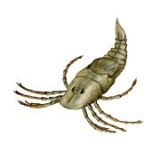
Megarachne
Encyclopedia
Megarachne servinei, the only species
belonging to the genus
Megarachne, was an Upper Carboniferous (Pennsylvanian
) eurypterid
found near Córdoba, Argentina
. It was originally described as a spider
with a body length of 339 millimetres (13.3 in), which would have made it the largest spider ever to have existed. In 2005, the fossil specimen was reexamined and determined to be a small eurypterid within the family
Mycteroptidae rather than a spider.
Species
In biology, a species is one of the basic units of biological classification and a taxonomic rank. A species is often defined as a group of organisms capable of interbreeding and producing fertile offspring. While in many cases this definition is adequate, more precise or differing measures are...
belonging to the genus
Genus
In biology, a genus is a low-level taxonomic rank used in the biological classification of living and fossil organisms, which is an example of definition by genus and differentia...
Megarachne, was an Upper Carboniferous (Pennsylvanian
Pennsylvanian
The Pennsylvanian is, in the ICS geologic timescale, the younger of two subperiods of the Carboniferous Period. It lasted from roughly . As with most other geochronologic units, the rock beds that define the Pennsylvanian are well identified, but the exact date of the start and end are uncertain...
) eurypterid
Eurypterid
Eurypterids are an extinct group of arthropods related to arachnids which include the largest known arthropods that ever lived. They are members of the extinct order Eurypterida ; which is the most diverse Paleozoic chelicerate order in terms of species...
found near Córdoba, Argentina
Córdoba, Argentina
Córdoba is a city located near the geographical center of Argentina, in the foothills of the Sierras Chicas on the Suquía River, about northwest of Buenos Aires. It is the capital of Córdoba Province. Córdoba is the second-largest city in Argentina after the federal capital Buenos Aires, with...
. It was originally described as a spider
Spider
Spiders are air-breathing arthropods that have eight legs, and chelicerae with fangs that inject venom. They are the largest order of arachnids and rank seventh in total species diversity among all other groups of organisms...
with a body length of 339 millimetres (13.3 in), which would have made it the largest spider ever to have existed. In 2005, the fossil specimen was reexamined and determined to be a small eurypterid within the family
Family (biology)
In biological classification, family is* a taxonomic rank. Other well-known ranks are life, domain, kingdom, phylum, class, order, genus, and species, with family fitting between order and genus. As for the other well-known ranks, there is the option of an immediately lower rank, indicated by the...
Mycteroptidae rather than a spider.

